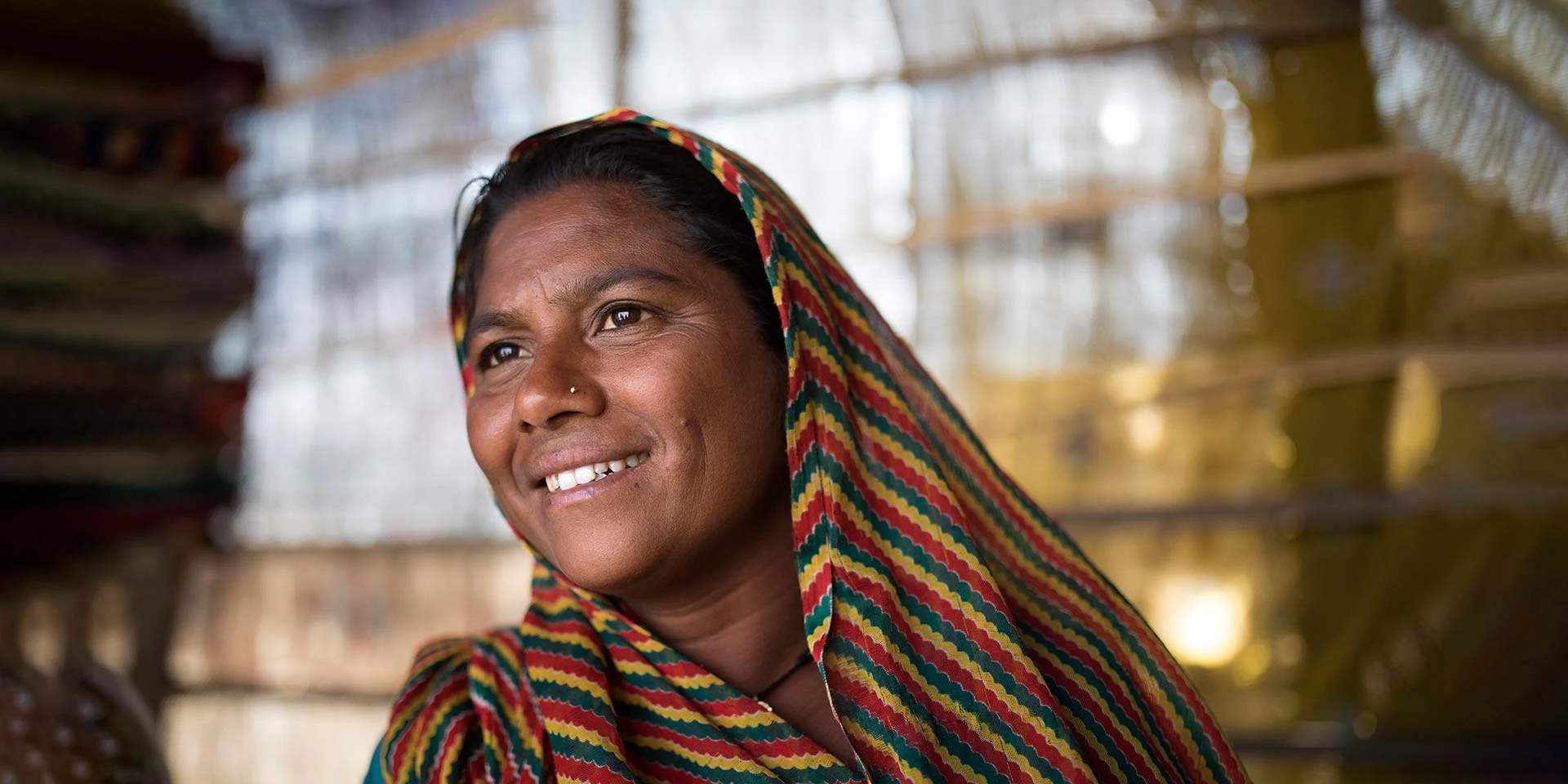DHRANGADHRA, India—Like tens of thousands of other farmers, Komal Sanura and her family travel each year to Little Rann of Kutch, in the Indian state of Gujarat, to harvest salt from briny underground water. When the Arabian sea recedes from this land in September, it leaves behind vast amounts of salt water below the surface. This is when the Agariyas—a community of salt farmers who have worked on this land for centuries--arrive from nearby villages to produce salt from this annually-renewed source.
Most of the Agariyas are women, and their colorful saris and sequined salwar kameezes shine bright against the barren, cracked earth. Here, families fashion makeshift homes from jute bags, plastic sheets, and bamboo poles, and work from September to April. It is arduous labor. First, workers dig wells to pump the salt water from the ground. To do this, they must manually move and roll the earth to create shallow, rectangular pans that collect the salt for slow evaporation under the hot desert sun. Later, they rake these pans until large crystals of salt are left behind to be harvested by hand.
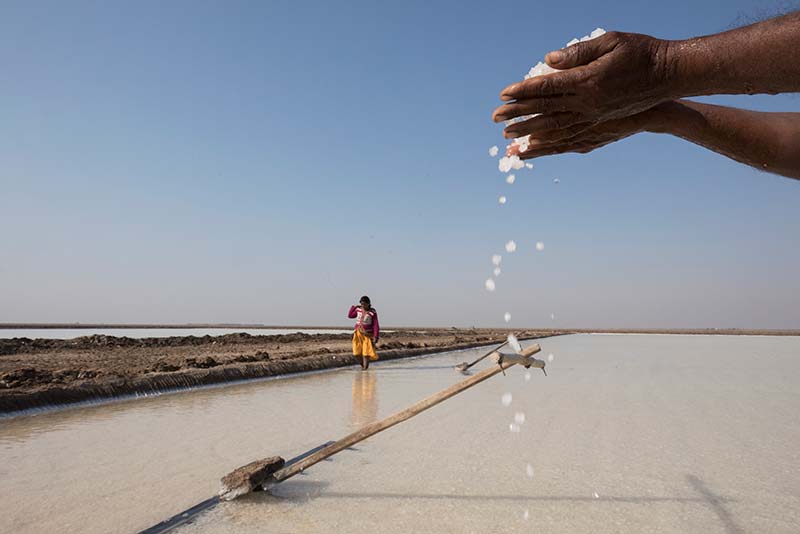
Ramesh Dudiwadia, a salt pan worker, inspects his salt in Little Rann of Kutch, India.
“When I wake up in the morning, I go to the salt farm and work there all day,” says Sanura. “It’s hard work.”
Up to 76 percent of India’s salt is produced on this land. But the Agariyas have for generations been compensated little for their labor, and they must pay for their own supplies. These salt farmers earn an average of only 150 Indian rupees ($2.10) per ton of salt—even though the market price is 17,000 Indian rupees per ton ($239). Exploitative intermediaries pocket most of their earnings. Moreover, the average family spends about 60 percent of its annual income on diesel to power pumps that draw salt-saturated water from the earth into the pans. This annual fuel expense is a major factor in keeping the Agariyas, who have no collateral or income outside of the salt-harvest season, locked in a perpetual cycle of poverty and debt.
Video by Stephan Bachenheimer
Until recently, the salt farmers were compelled to accept the prices set by middlemen and moneylenders. But for the last few years, the Self-Employed Women’s Association (SEWA), a trade union of more than 2 million women, has been advocating low-rate loans tailored to their situation. With support from the Government of Japan, IFC helped SEWA build a partnership with Bank of Baroda, one of the largest banks in India, to introduce a low-cost credit channel that is now available to the entire community of 15,000 women salt farmers who are SEWA members. The recipients had previously been ineligible to borrow on commercial terms.
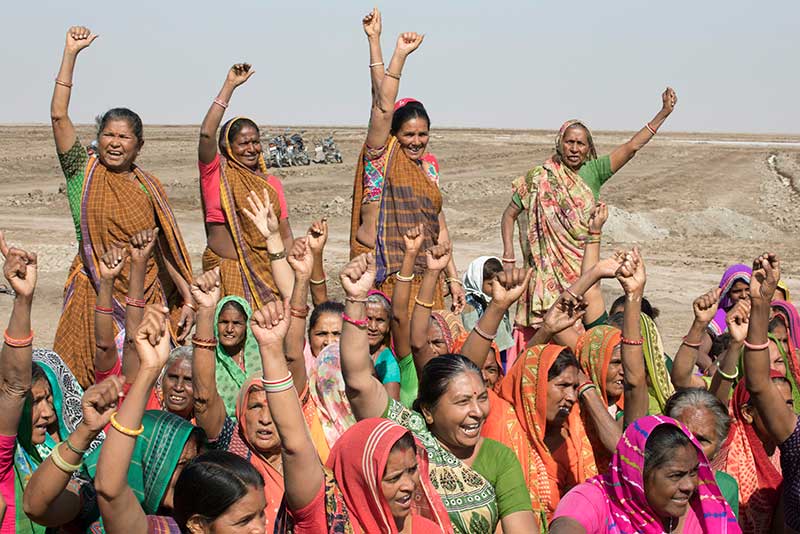
Salt pan workers celebrated during the closing remarks of an IFC event and site visit in Little Rann of Kutch, India.
IFC’s technical and advisory support to SEWA resulted in market-based financing that has helped SEWA members replace expensive diesel pumps with more cost-effective and sustainable solar-powered water pumps, impacting the lives of more than 12,000 people. In 2018, SEWA’s solar irrigation project received Gold Standard (carbon offset) registration and the sale of 19,000 voluntary carbon credits from the installation of 700 pumps in the first year, made for $25,000 in additional revenue among women salt farmers. The second issuance of carbon credits is slated to commence soon and is likely to benefit 1,200 women farmers. As of late 2020, over 4,000 solar pumps have been installed. According to the most recent estimate, this has allowed SEWA members to reduce fuel costs by 44 percent, increase salt production by 30 percent, and increase their average gross income by 33 percent. SEWA aims to provide this financing to all 15,000 members by 2023, ushering in a more sustainable means of salt production and more equitable incomes for the farmers.
Building Stable Financial Futures
During the last decade, India has improved its citizens’ standard of living: more than 90 million people were lifted out of extreme poverty between 2011 and 2015. But the country is still home to more than 176 million poor people, like the Agariyas. The SEWA-facilitated low-rate loans, with terms tailored to the Agariyas’ needs, may ease the burden placed on this unique community.
“IFC’s key value-add was bringing the interest rate down from 13 percent on such loans to 4 percent,” said Jun Zhang, IFC’s country manager for India. Families pay installments only during the salt-production season, instead of throughout the entire year.
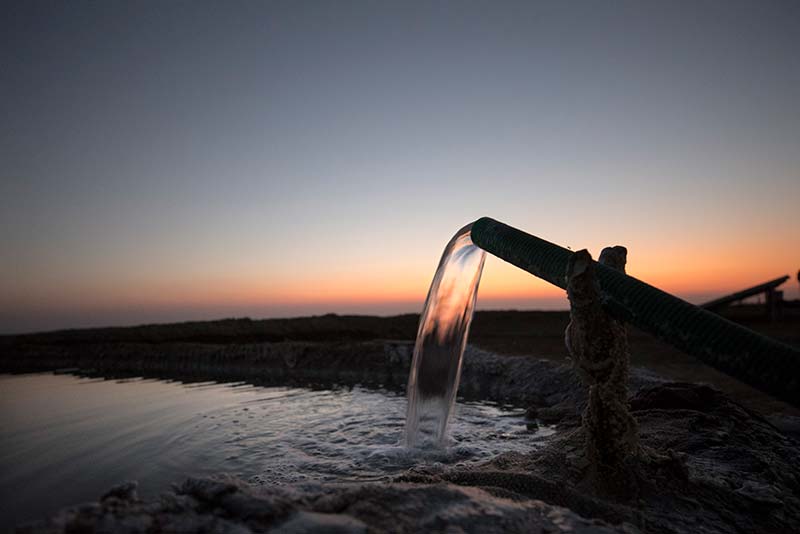
Energy from solar panels, pump up salty groundwater into salt pans as the sun sets in Little Rann of Kutch, India.
The solar pumps purchased with these low-rate loans start to pay dividends almost immediately. After the Sanura family began using solar pumps, for example, their family’s expenses dropped by nearly two-thirds and they reduced their diesel consumption by 1,600 liters. On average, families using the solar pumps save about Indian rupees 55,000 ($793) per season. After the installments on the solar pumps are paid off within two years--with the help of a government subsidy acquired with SEWA’s assistance--the Sanura family plans to use its increased earnings to purchase essentials and support the children’s’ needs.
With India’s nearly 300 sunny days and high solar radiation, solar pumps are a promising solution that may “completely replace diesel from the salt production process,” says Heena Dave, a rural organizer for SEWA. The solar pumps will also be useful during the off season (April to September), when they will power up a 2.7 MW solar park now under construction near Dhranghdhra. The solar park will be fully owned and operated by SEWA.
Planning for Vulnerability
The Agariyas’ poverty and limited work options leave them vulnerable to crises that may cause continual interruptions to their income. With strict lockdowns imposed in India at the start of the COVID-19 health crisis, salt farmers were especially susceptible to income loss because they live on monthly advance payments from salt traders. Since many traders returned to their villages during the pandemic, farmers were often left without their monthly advance.
SEWA’s coordination with district administrators helped avert dire economic consequences. Working closely with local officials, SEWA has helped salt farmers access food rations. SEWA also organized transportation permits to move the season’s salt harvest to the market.
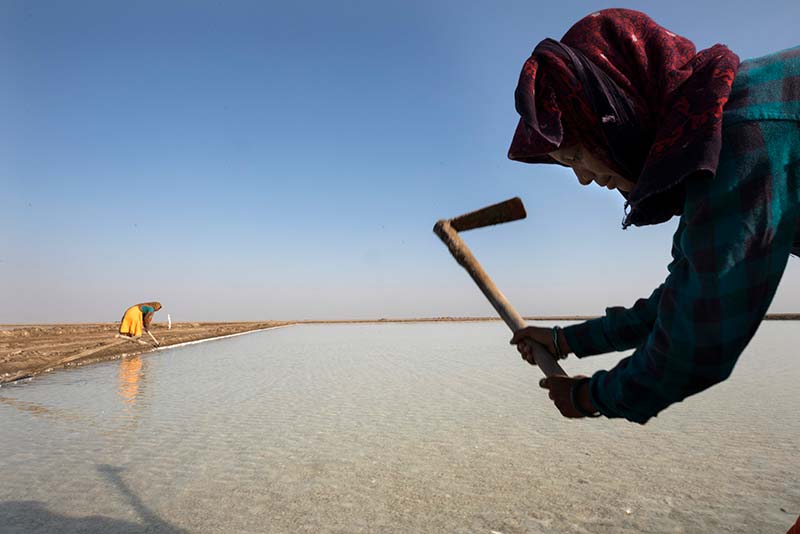
Komalben Rajnik Rapucha, (right) and Hansaben Rameshbhai Dodivadiya (left), salt pan workers, maintain and repair the banks of salt pans in Little Rann of Kutch, India.
“With no means of transportation, the issue of wastage of this year’s salt stock was looming,” according to farmer Gauri ben Thakore. “SEWA arranged the transportation services to carry the produced salt to the market with the help of local administration. This helped us gain our returns to support us during the pandemic crises,” she said.
The salt farmers are vulnerable in other ways that SEWA is trying to address. They are disproportionately susceptible to climatic shocks such as cyclones, for example. Cyclones cause strong winds to mix salt with earth, which reduces the quality and price of the harvest and the Agariyas’ income. SEWA’s credit facility aids farmers whose salt crops are affected by weather, and the organization also provides a weather-alert warning. To protect against the fluctuating income from weather-related changes, SEWA is advocating with the government to recognize salt farming as a form of agriculture, such as the cultivation of wheat. With this categorization, the government would ensure a minimum price for salt—as it does with many farming outputs like rice.
SEWA is also seeking to improve housing and education to help Agariyas achieve greater stability. One program under discussion would support Agariya families in acquiring modular prefabricated mobile homes that can be moved to their villages for the off-season. In addition, SEWA is exploring opportunities to build educational facilities for children, so they can learn during their parents’ eight months of work in the salt desert.
The long-term partnership between SEWA and IFC dates back over 15 years, when IFC first helped SEWA establish its SEWA Manager’s School. The program helped SEWA create 60 training modules on awareness, empowerment, and technical skills management, train over 800,000 women, and supported 85,000 women and their groups in the launch of new microenterprises. With the Government of Japan joining this partnership in 2019, IFC is now working with SEWA to implement its 2025 Transformation Program, ensuring there will be greater opportunities for many more entrepreneurs like Komal Sanura.
Join the conversation: #IFCmarkets
Published in March 2021
